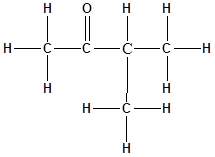
Concept explainers
(a)
Interpretation: Molecular formula needs to be determined for
Concept introduction: Atoms combine to form molecules. Molecular formula is the chemical formula, which shows actual number of atoms of each element present in the molecule of the compound.
(a)
Answer to Problem 5E
Explanation of Solution
The structure of the molecule is as follows:

Total number of ‘C’ atom = 3
Total number ‘H’ atom = 6
Total number of ‘O’ atom = 2
Therefore the molecular formula is
(b)
Interpretation: The molecular formula needs to be determined for
Concept introduction: Atoms combine to form molecules. Molecular formula is the chemical formula, which shows actual number of atoms of each element present in the molecule of the compound.
(b)
Answer to Problem 5E
Explanation of Solution
The structure of the molecule is represented as follows:

Total number of ‘C’ atom = 5
Total number ‘H’ atom = 10
Total number of ‘O’ atom = 1
Therefore, the molecular formula is
(c)
Interpretation: Molecular formula needs to be determined for the compound
Concept introduction: Atoms combine to form molecules. Molecular formula is the chemical formula, which shows actual number of atoms of each element present in the molecule of the compound.
(c)
Answer to Problem 5E
Explanation of Solution
The structure of the molecule is as follows:

Total number of ‘C’ atom = 5
Total number ‘H’ atom = 10
Total number of ‘O’ atom = 1
Therefore the molecular formula is
(d)
Interpretation: Molecular formula needs to be determined for the compound
Concept introduction: Atoms combine to form molecules. Molecular formula is the chemical formula, which shows actual number of atoms of each element present in the molecule of the compound.
(d)
Answer to Problem 5E
Explanation of Solution
The structure of the molecule is as follows:

Total number of ‘C’ atom = 4
Total number ‘H’ atom = 8
Total number of ‘O’ atom = 2
Therefore, the molecular formula is
(e)
Interpretation: Molecular formula needs to be determined for the compound
Concept introduction: Atoms combine to form molecules. Molecular formula is the chemical formula, which shows actual number of atoms of each element present in the molecule of the compound.
(e)
Answer to Problem 5E
Explanation of Solution
The structure of the molecule is as follows:

Total number of ‘C’ atom = 4
Total number ‘H’ atom = 11
Total number of ‘N’ atom = 1
Therefore, the molecular formula is
(f)
Interpretation: The molecular formula needs to be determined in the compound
Concept introduction: Atoms combine to form molecules. Molecular formula is the chemical formula, which shows actual number of atoms of each element present in the molecule of the compound.
(f)
Answer to Problem 5E
Explanation of Solution
The structure of the molecule is as follows:

Total number of ‘C’ atom = 4
Total number ‘H’ atom = 4
Total number of ‘O’ atom = 2
Therefore, the molecular formula is
Chapter U2 Solutions
Living By Chemistry: First Edition Textbook
Additional Science Textbook Solutions
College Physics: A Strategic Approach (3rd Edition)
Genetic Analysis: An Integrated Approach (3rd Edition)
Anatomy & Physiology (6th Edition)
Chemistry: An Introduction to General, Organic, and Biological Chemistry (13th Edition)
Microbiology: An Introduction
Human Physiology: An Integrated Approach (8th Edition)
- pls help asaparrow_forward11. Use the equation below to answer the following questions: 2 Al(s) + 3 Cd(NO3)2 (aq) → 2 Al(NO3)3 (aq) + 3 Cd(s) a. What is the net ionic equation for the reaction? b. Which species is a spectator ion in this reaction? Define a spectator ion. c. Identify the oxidizing agent and the reducing agent.arrow_forwardpls help asaparrow_forward
- 22arrow_forwardPLEASE READ!!! I DONT WANT EXAMPLES, I DONT WANT WORDS OR PARAGRAPHS FOR THE MECHANISM!!! THANKS First image: QUESTION 6. I have to show, with ARROWS and STRUCTURES, the mechanism of the reaction at the bottom. Also I have to show by mecanism why the reaction wouldn't work if the alcohol was primary. I also tried to draw the mechanism, tell me what to change. Please note that its an AMIDE thats formed not an AMINE the nitrogen has ONE hydrogen and one Phenyl-C-Phenyl. I already asked for this mechanism and got as a final product ...-NH2 not whats shown on the picture, thank you Ths second part. QUESTION 3. I just need a way to synthesize the lactone A, I already started please continue from where I left it Second image: I simply need the products, substrates or reagents, thank youarrow_forwardIndicate how to prepare a 10% sodium hydroxide (NaOH) solution to a slightly alkaline pH.arrow_forward
- CH, CH CH₂ CH₂ Phytyl side chain 5. What is the expected order of elution of compounds A-D below from a chromatography column packed with silica gel, eluting with hexane/ethyl acetate? C D OHarrow_forwardPlease analze my gel electrophoresis column of the VRK1 kinase (MW: 39.71 kDa). Attached is the following image for the order of column wells and my gel.arrow_forward2.0arrow_forward
 ChemistryChemistryISBN:9781305957404Author:Steven S. Zumdahl, Susan A. Zumdahl, Donald J. DeCostePublisher:Cengage Learning
ChemistryChemistryISBN:9781305957404Author:Steven S. Zumdahl, Susan A. Zumdahl, Donald J. DeCostePublisher:Cengage Learning ChemistryChemistryISBN:9781259911156Author:Raymond Chang Dr., Jason Overby ProfessorPublisher:McGraw-Hill Education
ChemistryChemistryISBN:9781259911156Author:Raymond Chang Dr., Jason Overby ProfessorPublisher:McGraw-Hill Education Principles of Instrumental AnalysisChemistryISBN:9781305577213Author:Douglas A. Skoog, F. James Holler, Stanley R. CrouchPublisher:Cengage Learning
Principles of Instrumental AnalysisChemistryISBN:9781305577213Author:Douglas A. Skoog, F. James Holler, Stanley R. CrouchPublisher:Cengage Learning Organic ChemistryChemistryISBN:9780078021558Author:Janice Gorzynski Smith Dr.Publisher:McGraw-Hill Education
Organic ChemistryChemistryISBN:9780078021558Author:Janice Gorzynski Smith Dr.Publisher:McGraw-Hill Education Chemistry: Principles and ReactionsChemistryISBN:9781305079373Author:William L. Masterton, Cecile N. HurleyPublisher:Cengage Learning
Chemistry: Principles and ReactionsChemistryISBN:9781305079373Author:William L. Masterton, Cecile N. HurleyPublisher:Cengage Learning Elementary Principles of Chemical Processes, Bind...ChemistryISBN:9781118431221Author:Richard M. Felder, Ronald W. Rousseau, Lisa G. BullardPublisher:WILEY
Elementary Principles of Chemical Processes, Bind...ChemistryISBN:9781118431221Author:Richard M. Felder, Ronald W. Rousseau, Lisa G. BullardPublisher:WILEY





